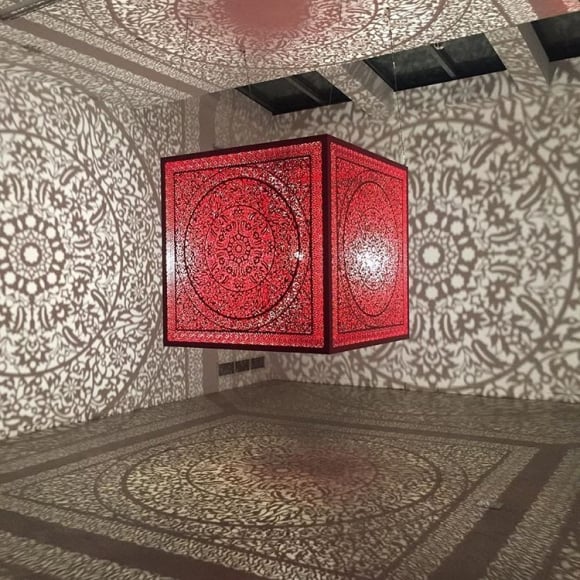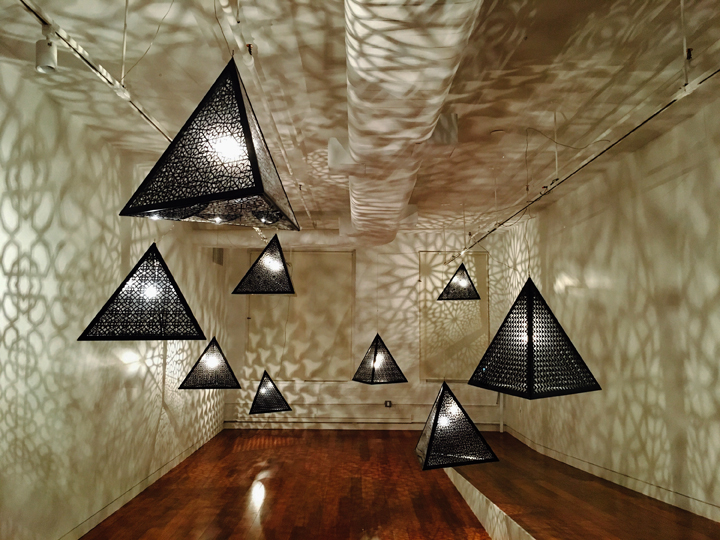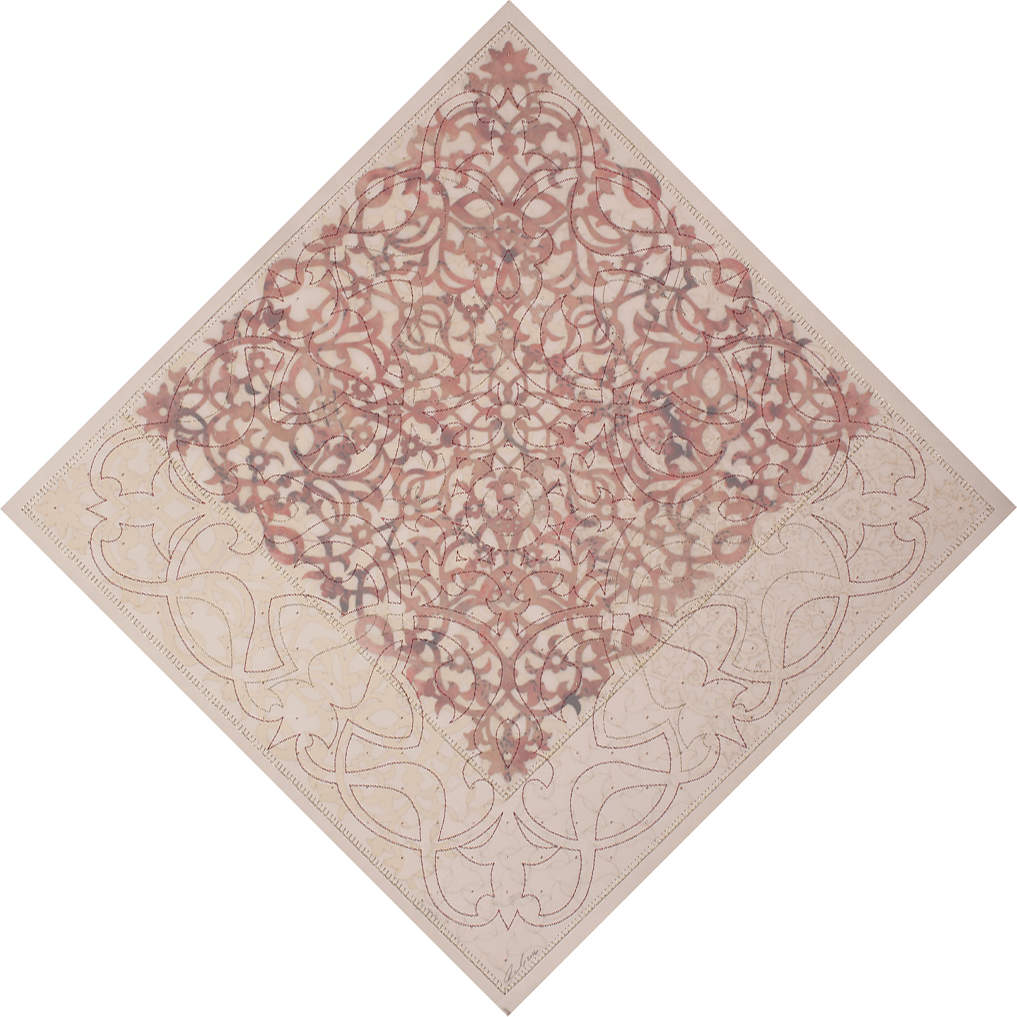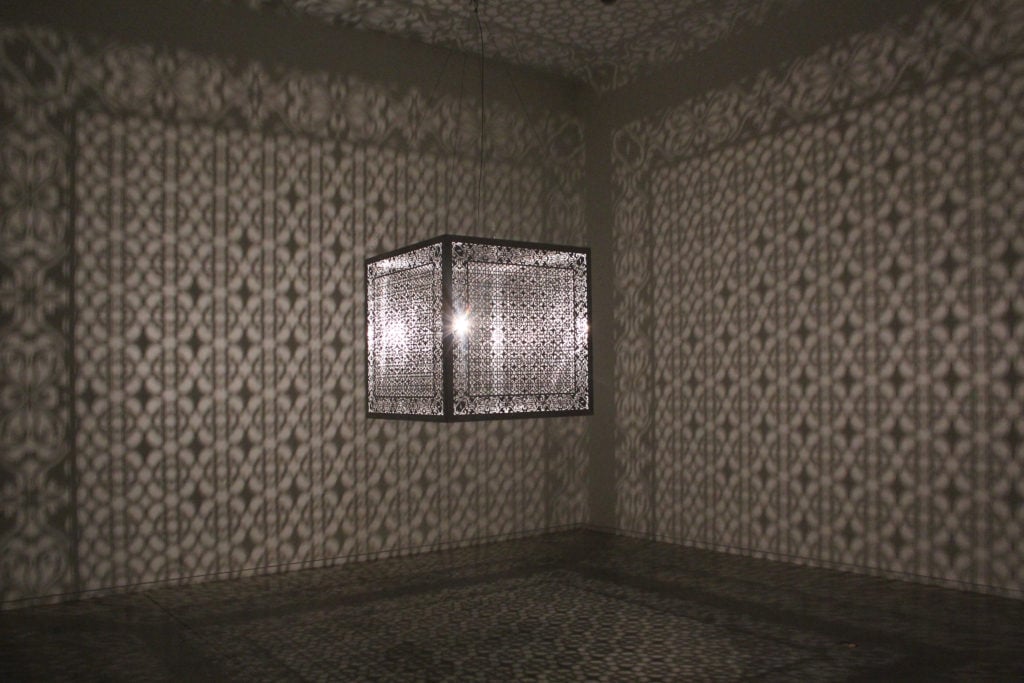People
artnet Asks: Anila Quayyum Agha on Drawing Inspiration From Darkness
Her current show, "Walking with my Mother’s Shadow,” closes November 27 in New York.

Her current show, "Walking with my Mother’s Shadow,” closes November 27 in New York.

Artnet Galleries Team

“Walking With My Mother’s Shadow,” the current exhibition by Pakistani-American artist and recent ArtPrize winner Anila Quayyum Agha, offers an unabashedly gorgeous and emotional experience to viewers. In her first major New York solo show, Agha explores love and loss through highly intricate and conceptually complex sculptures. Featuring delicate patterning, her work operates at the intersection of between differing cultures, people, and memories.
Here, she discusses her current show and from where she draws inspiration—including from the darkest moments in our lives.
Tell us about your current solo show, “Walking with my Mother’s Shadow,” at Aicon Gallery.
Celebration and loss of loved ones and our memories of them manifest in several ways. Often we experience a spectrum of emotion, beginning with deep joy, or deep sorrow, turning to quiet acceptance over time. My current work reflects on the complexities of love, loss and gains I have experienced over the past year. It also attests to losses and gains experienced and endured by people across the world for many reasons, such as war, oppression and censorship.
I had just returned to the United States from Lahore, Pakistan early this year when I received the dreaded phone call that every immigrant fears: My mother had died. I had just seen her, touched her, talked to her, and now she was no more. I had been in Lahore to attend my son’s wedding and my moments with my mother had been short and snatched, sandwiched between the rituals and celebrations of the wedding. As is the custom in Islam, she was buried within a day of her passing. There was no question of going; she was gone.
The works in this exhibition were borne of the varied mix of emotion that followed my son’s wedding and my mother’s passing. On a larger level, it was the communal sense of loss—of loved ones, identities, homes and countries—experienced by myriad people across a world ravaged by the atrocities of war and displacement that created equivalence. It added poignancy to my personal loss and the global loss I bear witness to daily via the news media. This work also reflects my joy for my son and his future life alongside of the lives of many people across the world who have been given second chances through resettlement in new lands but who will always carry with them a sense of loss.

Anila Quayyum Agha, Alhambra Nights. Courtesy of Aicon Gallery.
Can you talk about how your materials are used in the show?
Materials such as steel cut with delicate patterns, or embroidery and beads on white, black and brown paper, reflect and refract light. They represent space that belongs to one more than the other, evaluate the color of my body and the bodies of others, and the cycles of life and death. The series in white reference the white of marble gravestones and shrouds, both of which are a central element of death and its commemoration in Pakistan. The black drawings speak of the surface and the hidden layers often not seen or mined. The brown drawings talk of our bodies, and the longing to belong and to matter. The red and black sculptural installations magnify floral and geometric motifs to inhabit a large space, covering and beautifying all that are in it.
In the floral beauty of the patterns and layers, the cuts and embroidery strive to capture the identity, beauty, and femininity of my mother and other mothers—me, you, us—that become obscured by gravestone and shroud. These patterns pay homage to the organic to which death is inevitably linked but from which new life also emerges. The many colored, metallic embroidery threads in these works are often used in women’s wedding dresses in Pakistan but never for shrouds. In stitching these threads into paper, and cutting patterns in steel, I connect the wedding that is believed the beginning of a woman’s life-giving journey, and the funeral that is its ultimate end. This interplay of the nuptial and the funereal invites us to cherish our losses, more so because they are intrinsically connected to life’s most beautiful moments such as holding a hand that may soon be no more. Together, the wedding and funeral suggest the larger cycle of life binding us through gossamer fragility and beauty of a bloom that will undoubtedly fade.

Anila Quayyum Agha, I Will Find the Flowers. Courtesy of Aicon Gallery.
What are some of the challenges you have faced as a female artist? As a Pakistani artist?
I often think that, had I not moved to the United States, I would not be a professional artist, and for that I’m very grateful. Additionally, being of Pakistani origin, there are and have been preconceived ideas that I have had to dispel but also accept as part of my narrative. The amazing legacy of Islamic art and architecture poses a burden but also opportunity for contemporary artists emerging from the Islamic world. I believe contemporary artists of the modern Islamic nations have a great deal to contribute that may need to have a broader frame of understanding. Societies are more fluid now, with cross-cultural movement. The emergence of new ideas and scholarship about identity and or privilege, political issues, and reforms within the post-colonial world is generating intense scrutiny. The confluence of East and West allows for investigations into culture and religion, thus fueling more scholarship into human rights and education. We, who are from the Islamic world, need to continue to examine our own histories, intentions, reasoning, and responsibilities to allow for the wider world to follow suit, to broaden the frame of understanding, to be represented equally. That may still happen in my lifetime.
Some of the challenges I faced in the United States were often connected to being culturally different. I was once told by an art history professor—very compassionately—that I had three jeopardies to deal with in my career choice: First, that I was a woman, second that I was of Pakistani origin, and thirdly that I wanted to make work about social issues connected to women. Her comment made an impression on me. It also made me work twice as hard to merely make my presence known. Hard work is not difficult but being forgotten is often the hardest thing to deal with.
You attended the University of North Texas for your MFA. Was that your first time in the States? What was your first impression of life in America?
First impressions as an immigrant are often associated with feelings of displacement, and not fitting in. America is home for me now and has been for the last 16 years, but the beginning was challenging.
Pursuing an art degree anywhere in the world often brings forth questions of survival. Graduate school was extremely important for me as I learned to be independent and resilient. There was no one to fall back on, so failure was simply not an option.

Anila Quayyum Agha, Shimmering Mirage. Courtesy of Aicon Gallery.
Some of your past work has been inspired by the Alhambra, a Moorish palace in Spain. Can you talk to us about what this body of work was inspired by?
In Intersections and the subsequent derivations of the cube, the geometrical patterning in Islamic sacred spaces, associated with certitude is explored in a way that reveals it fluidity. The viewer is invited to confront the contradictory nature of all intersections, while simultaneously exploring boundaries. My goal in the installations was to explore the binaries of public and private, light and shadow, and static and dynamic by relying on the purity and inner symmetry of geometric design, and the interpretation of the cast shadows. The form of the design and its layered, multidimensional variations depends both on the space in which it is installed, the arrangement of the installation, and the various paths that individuals take while experiencing the space.
The Intersections project takes the seminal experience of exclusion as a woman from a space of community and creativity such as a Mosque and translates the complex expressions of both wonder and exclusion that have been my experience while growing up in Pakistan. The frieze emulates a pattern from the Alhambra, which was poised at the intersection of history, culture and art and was a place where Islamic and Western discourses, met and co-existed in harmony and served as a testament to the symbiosis of difference. For me the familiarity of the space visited at the Alhambra Palace and the memories of another time and place from my past, coalesced in creating these projects. My intent with the installations was to give substance to mutualism, exploring the binaries of public and private, light and shadow, and static and dynamic. The Intersections installation project relies on the purity and inner symmetry of geometric design, the interpretation of the cast shadows and the viewer’s presence with in a public space.
What’s next for you?
Currently I am planning a new project for MOCA in Jacksonville, FL for 2017. I will also be participating in a group show at the North Carolina Museum of Art in Raleigh, NC and the Katonah Museum of Art in upstate New York.
The artnet Gallery Network is a community of the world’s leading galleries offering artworks by today’s most collected artists. Learn more about becoming a member here, or explore our member galleries here.